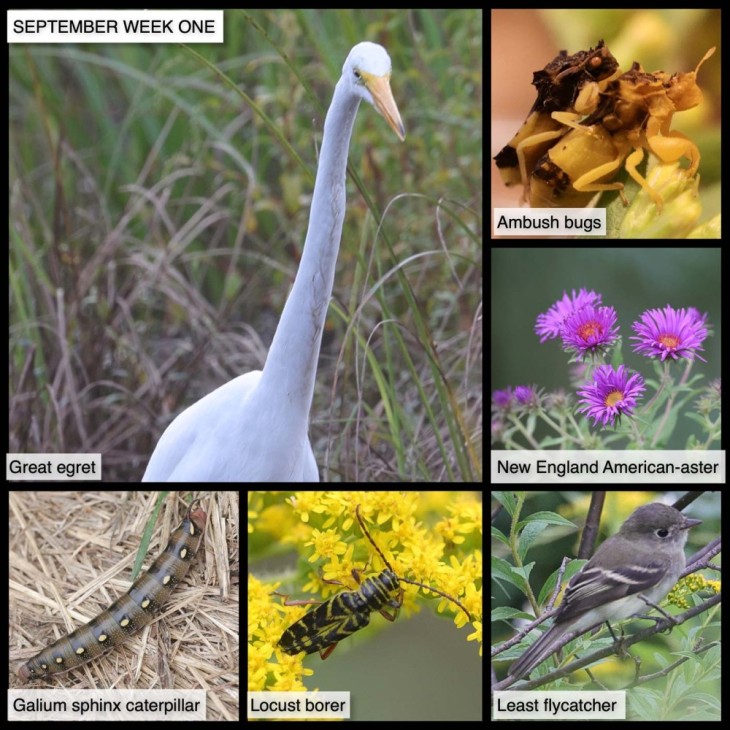This Week in the Woods, we never actually made it into the woods, because we got distracted by so much interesting life at the trees’ edge. We found this great egret stalking frogs in a roadside wetland. This bird is a conservation success story, and a national symbol for the Audubon Society. As noted in this article from Smithsonian Magazine, great egrets were almost wiped out due to nineteenth century fashion demand for their feathers, but the passage of the Lacey Act in 1900, the Migratory Bird Act of 1918, and other hard-fought legislation helped to save them from extinction.
Here are some other nature sights this week (clockwise):
Blooming goldenrod (multiple species) offers food and habitat for a diversity of insects, including tiny but fearsome ambush bugs. You need magnification to get a good look them – otherwise, they’re easy to mistake for goldenrod petals – but when you do, you’ll find armored bugs with grasping, praying mantis-like front arms. Ambush bugs use these arms to seize much larger prey (including wasps!), which they pierce with specialized mouthparts, inject with paralyzing, liquifying enzymes, and then drink dry. Bon appetit! Here’s an Outside Story about them by Steven Shepard.
There are many species of asters blooming now, to insects’ delight and botanizers’ frequent befuddlement. (How fuzzy is the stem? And what is the precise form of the involucral bract?) One of the most eye-catching and easily identified species is New England American-aster, which is taller than most other asters and has an especially crowded array of bright purple ray flowers (what we think of as petals, which circle the yellow disk flowers in the center). Here’s a profile from the Native Plant Trust.
We found several dainty least flycatchers fluttering about in a stand of alders. Northern Woodlands Associate Director Dan Lambert identified this bird, explaining that you can detect it in the field by its repetitive "che-bek" call. “Leasts most closely resemble willow and alder flycatchers,” he explained. “But they can be separated by the distinct eye ring and slightly stubbier bill.” Here’s a profile from the Cornell Lab’s All About Birds site, which notes the species’ habit of nesting in clusters, “creating a flycatcher neighborhood.”
As their name indicates, locust borers depend on locust trees for their lifecycle. The larvae live in and feed on the wood. The adult beetles have zigzag black and yellow markings and can easily be mistaken for yellow jackets when they land in your hair (no, they don’t sting). They’re active in September, and as shown in this image, you can often find them feeding on goldenrod pollen. Here’s a profile from bugguide.net.
Finally, an observant 10-year-old saved this gallium sphinx caterpillar from squashing after it made the poor decision to rest on a hiking trail. Assuming it survives the rest of its larvahood and pupation, this caterpillar will turn into an exquisitely marked gallium sphinx hawk moth, also called a bedstraw hawk moth. Check out this photo of the moth by Mary Holland on her Naturally Curious site. As she notes, hawk moths (which also include the adult form of the tomato hornworm) are able to fly at high speeds, some as fast as 30 miles per hour!
Our thanks to The Bailey Charitable Foundation and the Frank and Brinna Sands Foundation for helping to support this series.
In this difficult period, many of us find joy in observing local nature. This series, launched in April 2020, shares nature photographs taken in the past seven days, or in the same week in 2020, most within 15 miles of the Northern Woodlands office in Lyme, New Hampshire. We hope you enjoy using this grid as a prompt for your own explorations.
What are you seeing in the woods this week? Share your images with us on Facebook, or submit a special photo for possible inclusion in our monthly online Reader Photo Gallery.


